When I first laid eyes on the neglected and overgrown property I would soon call my own, I saw through the saplings and trees that engulfed the pastures of the historic farm. I saw potential, and knew that with time and work it could be restored to its former use of pastureland again. It was apparent that no land management had been practiced on the 200-year-old farm for at least half a century. That meant in addition to the trees, there were decades’ worth of leaf litter and forest floor cover to work through to unearth the soil below.
What I did not see or plan for was the price tag attached to the equipment required to do all of this work mechanically, as well as the cost of properly fertilizing the land in preparation for seeding. To add insult to injury, being a New England farm, the land is riddled with ledge and boulders, which would make navigating any kind of equipment through the rock minefield nearly impossible. All of these barriers forced me to seek out a more natural method to work the land while simultaneously fertilizing.
Pig as Plows
Pigs are the farm’s natural rototillers, and by utilizing intensive rotational grazing they can not only turn over the thick detritus with their snouts, but also provide necessary aeration and fertilization to the soil in the process. Utilizing cover crops after moving the pigs out of a paddock provides erosion control while increasing biomass and fertility of the topsoil.
Rotational grazing is the practice of rotating livestock throughout paddocks. An intensive rotational grazing system uses this method as a way to maximize the quality and quantity of forage. Pigs will graze on young saplings, ferns, grasses, and weeds, but they are also notorious rooters. This behavior earns them a bad reputation for being destructive animals that will ruin any land they are raised on. With continual exposure, their pointy hooves and strong snouts can and will do significant damage to the land and, over time, deplete the soil’s quality. However, by exercising good land stewardship practices, this behavior can be used as an advantage to enrich the soil and turn woods into grazing land.
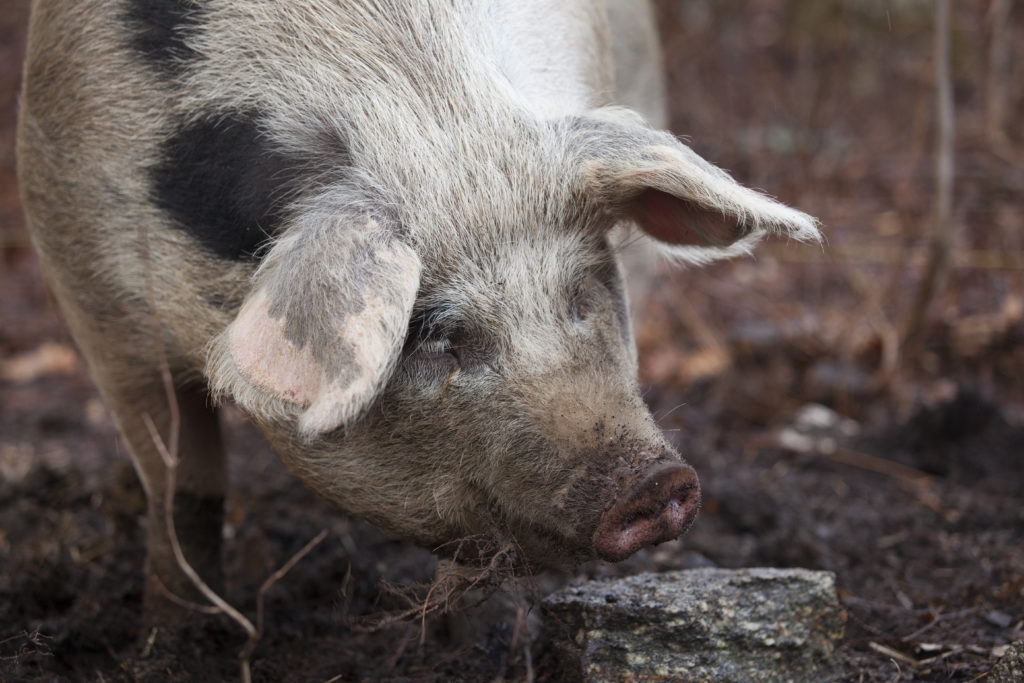
Prep Work
Before getting piglets, the land should be properly prepared and fenced. I prepared my area in the fall, knowing there was a good chance there would be snow on the ground when it was time to bring the piglets home the following spring. Because I wanted to create a silvopasture as opposed to open pasture, I selected hardwood trees to stay that would provide shade, shelter, and food for future livestock. After the choice trees were selected, everything else was cut down as close to the ground as possible. Pigs will root down several inches, even up to a foot or more around the stumps, allowing stumps to be cut below the soil line where they can be covered with dirt and seeded over in most cases. This drastically cuts down on the amount of work required with a stumper.
When implementing a rotational system, proper fencing design is critical to success. Poor fencing equates to pigs escaping and potentially never being recaptured. When trained properly to respect it, pigs can do very well on pasture that’s solely electric, without any permanent perimeter fence. My piglets had exposure to a hot wire when I got them, but for safe measure they spent their first couple of weeks at my farm in a training pen with hot wire surrounded by cattle panels before I was confident they wouldn’t test it. They spent the next six and a half months contained by electric alone, and never once attempted an escape. A three-strand perimeter at 4, 8, and 12 to 16 inches above the ground is ideal, as it will contain a pig of any size. The lower wires will prevent small piglets from being able to slip out underneath, while the top wire will be at nose and eye level for a 300-pound hog. To break up the perimeter into paddocks, polywire fence with insulated handles is preferable, as it’s the quickest and easiest to set up with fiberglass posts, giving the needed flexibility in a rotational setup.
Once the unwanted trees have been removed from the area and a perimeter has been established, a plan for paddock layout needs to be designed. The 1⁄3-acre area that I focused on is roughly rectangular in shape. My original plan was to divide this area into five rectangular paddocks of approximately equal size to rotate the pigs through from left to right.
I quickly learned that they have a tendency to focus on their favorite areas while leaving others seemingly untouched, and they were utilizing only approximately half of the space for forage. This forced me to divide each paddock in half, now creating 10 paddocks each roughly 1,450 square feet in size. Although the pigs were in a smaller area, they worked the land more evenly, and to compensate, were rotated more frequently to prevent the soil from being overworked.
The main concern with rotational grazing with any type of livestock is how often they should be moved onto new ground. The frequency of which they need to be rotated can vary depending on the number and size of the pigs as well as the paddock size. They should be kept on an area long enough that the ground is thoroughly worked, with any leaf litter and detritus turned over exposing the soil. They will eat invasive weed species, while stimulating growth of grasses and grazing forages through their rooting. Left in one spot for too long, pigs will cause the soil to become compacted.
The frequency of rotation is going to determine how long the paddock is able to rest before putting the pigs back on it. Once they are rotated out of a paddock, it should lie farrow for a minimum of 21 to 28 days. This fallow period may help to break the cycle of any parasites that are potentially present, while allowing cover crops and native grasses to grow back. I found the ideal rotating frequency to be two to three weeks, depending on the size of the pig. A small 50-pound pig will do significantly less damage and may be in a paddock for three weeks before being moved, as opposed to a 250-pound one that needs to be moved every two weeks or even less. With a 10-paddock setup and rotation frequency of every two weeks on average, the paddock is allowed to rest for 18 weeks before being worked again. This is more than enough time for parasite cycles to break and cover crops to flourish.
Cover Crops
Cover crops are a great way to add natural organic fertilizer to an area while providing additional forage for the pigs to consume. Depending on geographic location, season, and soil type, the choice of cover crop can change. Here in the Northeast, raising pigs from spring to early winter, the temperature ranges from below freezing to the mid-90s. Because of this drastic temperature swing between the seasons, the cover crops I use in the spring and fall months differ from those in the summer.
Cover crops are broken down into two main categories: legume and nonlegume varieties. Legume crops include perennial clover and winter annuals such as field peas, hairy vetch, and various clovers. Nonlegumes include the cereal grains (rye, wheat, barley), various grasses, and brassicas.
Traditionally, both of these crops are used as a way to fix nutrients into the soil, suppress weeds, and increase the biomass of the soil between planting seasons for crops. In a rotational grazing system, I use them as forage to supplement feed, as well as a way to add organic matter to the soil and prevent erosion while the paddock lies fallow between periods of the pigs grazing. The crops are not tilled by a tractor, but by the pig’s snout. Because of this, I focus on cover crops that grow as quickly as possible, provide ample forage, and turn into fertilizer quickly through decomposition.
Cover Crops to Consider:
- Buckwheat: A quick-growing nonlegume crop for summer and cool weather seasons. Not frost tolerant. Rejuvenates low-fertility soils, suppresses weeds, decomposes quickly to add organic fertilizer, and attracts beneficial insects.
- Barley: Cool-season nonlegume cereal grain. Provides excellent erosion control, suppresses weeds, and produces more biomass in a shorter time than any other cereal grain.
- Oats: Cool-season annual nonlegume crop. Inexpensive, suppresses weeds, prevents erosion, and improves productivity of legumes when planted in a mixture.
- Red Clover: Cool-season legume. Inexpensive, creates loamy topsoil, suppresses weeds, provides excellent forage, and is widely adapted to many soil types.
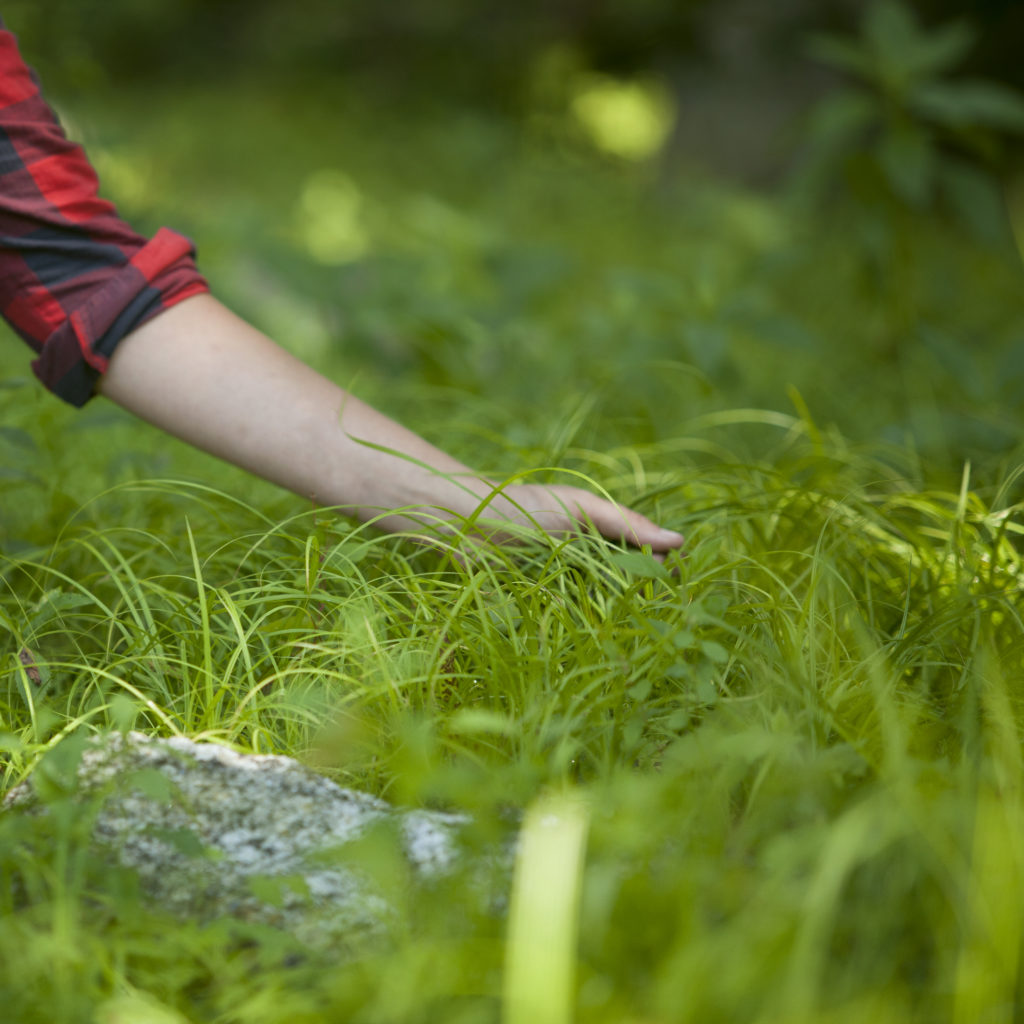
After rotating the pigs throughout the paddocks and seeding with cover crops behind them, the land was unrecognizable six months later. What used to be thick forest floor cover built up over several decades became rich, dark, loamy soil. No longer shaded by a canopy of trees, there is now sun exposure for native grasses to grow and pasture grasses to be sown in the spring.
Although using pigs to clear land is a slower method, they are able to simultaneously rototill and fertilize with ease regardless of the terrain. The additional use of cover crops not only adds organic biomass and natural fertilizer, but it also provides forage for the pigs as well, helping cut feed costs. Hiring a crew or renting equipment to come in and do the same work may take a fraction of the time, but it would come at an enormous cost and headache. Through the use of pigs, I was able to achieve the same result naturally, with the added bonus of filling the freezer with two 300-pound hogs. No matter the amount of acreage or the land’s layout, a rotational grazing system can be applied to naturally convert woods into usable pastureland.
This article appeared in the 2018 March/April issue of Grit Magazine
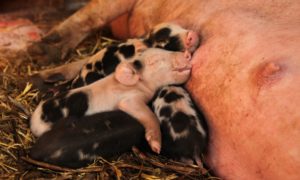
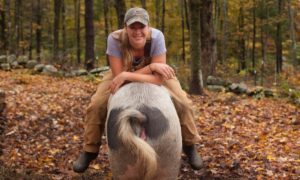
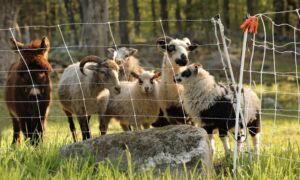
Pingback: Raising Pigs on Electric Fence | The Modern Day Settler
Pingback: How We Made Sheep Pasture out of Woods | The Modern Day Settler
Pingback: How Much Does it Cost to Raise a Pig for Meat? - The Modern Day Settler
Hello 🙂 did you clear the land first by yourselves via chainsaw?
Any cutting down of trees is done with a chainsaw!
Also, how to you manage water? That’s a struggle we had. We tried this once with three Gloucester old spots and experienced the heart wrenching “they got out and were never recaptured” scenario. We’ve been afraid to try since. Our ground wasn’t wet enough and our fencing failed.
Just found your blog by the way and am reading through each and every post and finding it all enormously helpful so thank you for putting all the time in!
OH darn. Yes, you definitely need some kind of moisture in the soil to get a proper ground! We manage water by filling a large water tank from the spiggot on our hose. The tank fits in the bucket of our tractor and has a hose attached to it so we just drive it around and top off everyones water. All of our animals are scattered and we move them, so there is no way to have a dedicated water source. This works for us.
We have a pond nearby and considered a pump to fill the waterer… just wondering how you transport water.